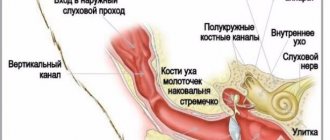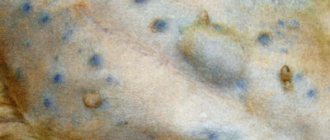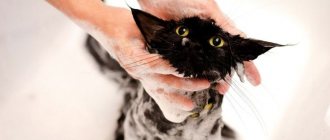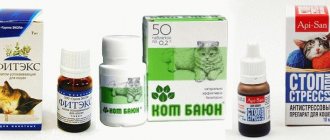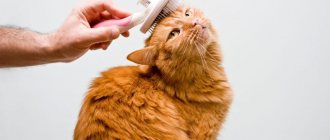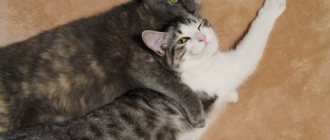7364Pavel
When owners notice that a cat has a bump on the withers, a variety of thoughts arise in their heads. In this situation, the first thing you should remember is whether your pet has recently been vaccinated.
A reaction in the form of bumps at the injection site after vaccination is a common occurrence in cats and dogs, and it does not matter how old the animal is: a year or ten. Read about the options for this complication, as well as other causes of a tumor on the withers of a cat, in this article.
© shutterstock
Is vaccination necessary?
Pets practically become members of the family. It is important that they maintain their health. However, there is always a risk of contracting dangerous diseases. Vaccinating your cat is a reliable and time-tested means of eliminating this risk.
However, in this case, temporary complications can sometimes occur. Vaccination is the infection of an animal with weakened pathogens, which it can easily cope with and develop immunity to this disease. This procedure protects not only the pet, but also its owner from serious dangers.
ATTENTION! If a cat experiences temporary complications, the caring owner is obliged to do everything possible to alleviate his suffering.
Sometimes it seems that by following a certain regime for a cat, you can guarantee the absence of infection. However, in reality it is impossible to completely avoid this danger. Even keeping a cat in an apartment does not guarantee its safety. Pathogenic microorganisms can be brought into the home, for example, on shoes.
Vaccination is necessary for the following reasons:
- Rabies is a deadly disease. Vaccination protects against it. But if this is not done, the animal may become infected and die.
- A sick pet becomes dangerous to other animals.
- A cat with rabies can infect humans with this deadly disease.
After the vaccination procedure, the risk of contracting an animal with rabies is completely eliminated.
How is it carried out?
In order to protect a cat from rabies, the first vaccination is carried out at the age of 12 weeks or a little later. As a result, the animal develops immunity that lasts for one year. To ensure reliable protection against rabies, vaccination is required annually.
It is recommended to reuse the vaccine from the same manufacturer. It is important to pay attention to how the pet tolerates the procedure . If it responds well to the vaccine from this particular manufacturer, then it makes sense to use it regularly. In the event that problems arise with vaccinations, it makes sense to consult a veterinarian about using another option.
After the injection, quarantine occurs for 14 days. During this period, the animal develops immunity. At this time, it is necessary to ensure that your pet appears on the street as little as possible and has contact with other animals. During the time when immunity is developed, the cat’s body is weakened and very vulnerable.
ATTENTION! If the procedure is performed in a veterinary clinic, this reduces the risk of adverse effects.
It is not recommended to leave immediately after the injection. It is better to wait 20 minutes to check for an allergic reaction. In this case, specialist help can be obtained immediately.
Bump on a kitten's withers
In small kittens, swelling on the neck may appear after receiving the rabies vaccine. Kittens begin to be vaccinated at 3 months of age and then annually. Most often, such a small bump goes away within 14 days.
But there are cases when swelling serves as a signal for the development of a severe allergic reaction, which can result in anaphylactic shock. It is not recommended to leave the hospital immediately after this vaccination. It is better to observe the condition of the kitten within the walls of the veterinary hospital for half an hour.
Types of complications
After vaccination, your pet often experiences temporary complications. They can be expressed as follows:
- an allergic reaction to the injection . It can be expressed, in particular, in the form of swelling, redness, and skin rashes. In such cases, an antihistamine is additionally administered. In extremely severe cases, anaphylactic shock may occur.
- may appear under the skin at the withers in the form of a small bump. The reason may be unprofessional administration of the vaccine or the individual characteristics of the animal’s body.
- Reduced immunity during the quarantine period increases the likelihood of other diseases or the appearance of worms.
- Sometimes vaccination can contribute to the manifestations of kidney failure. This is due to the fact that the vaccine is made from cat kidney cells. Once in the body, it can cause the formation of antibodies that act on this organ. The main cause of this complication is too frequent vaccination.
When a pet suffers during vaccination, a loving owner is obliged to do everything possible to support the animal and alleviate its suffering.
Other causes of bumps
If swelling appears, but the vaccination was given a long time ago or it was not given at all, it would be useful to remember the pet’s participation in fights.
Often, a hematoma is the result of the claws of a neighbor's cat.
And if there were no “cat fights”, then the cause could be:
- Bite of a tick or blood-sucking insect . Free-ranging mustachioed striped animals are at risk. In this case, you need to unscrew the tick yourself or contact a veterinarian. The remaining parts of the mite can cause inflammatory reactions, so under no circumstances should the insect be pulled out. After extraction, it is advisable to take a blood test to check for infections.
- Lipoma or wen is a tumor that is benign in nature . It looks like a small ball that rolls freely under the skin. It is recommended to remove the tumor only if it quickly increases in size and causes discomfort to the animal. In addition, one should not exclude the degeneration of the tumor into a malignant one. The main causes of lipoma are considered to be hormonal changes and disruptions in the endocrine system. In most cases, the lump is painless, but it can put pressure on nerve endings and muscles.
- Malignant neoplasms that have metastasized to the animal’s neck . If the lump is the result of cancer, only radical treatment methods can help. In the later stages, it is recommended to euthanize your furry pet.
- Allergic reaction . The appearance of swelling is usually accompanied by drooling, itching and nasal discharge. After a course of antihistamines and removal of the source of the allergy, the pet’s condition returns to normal and the lump resolves.
If there is a lump
One of the possible complications after vaccination is the formation of a lump at the injection site. First of all, it is important to determine the cause of what happened. If you contact a specialist, he will conduct a thorough analysis, determine the diagnosis and offer appropriate treatment.
Typically, the following means can be used for this:
- taking medications;
- use of compresses;
- in rare cases, surgery may be required.
Usually this problem is solved in no more than a week.
What does the appearance of a seal mean?
A caring owner should think about how to protect their pet from the danger of contracting rabies. However, sometimes after an injection a subcutaneous lump may appear, which causes concern about the cat’s health.
The appearance of a lump cannot be a reason for panic. This reaction to an injection is possible for several reasons:
- if the animal has an allergic reaction to the administered drug;
- when using a low-quality vaccine.
In most cases, the lump under the skin goes away without the need to take any measures . In a week, no trace of her will be visible. Usually, after an injection, the solution concentrates in one place, and within a few days it disperses throughout the body. The easiest way to take care of an animal in this situation is to help this process.
This can be done by applying a compress to the injection site (on the back of the neck or between the shoulder blades). To do this, take gauze, fold it in several layers and moisten it in an alcohol solution. The compress is applied to the area of compaction for 10 minutes. The procedure must be repeated twice during the day. After its completion, the sore spot is carefully wiped.
IMPORTANT! If the animal tends to scratch the injection site, the use of antihistamines to reduce itching may help.
However, in rare cases, the appearance of a lump indicates more serious things:
- The appearance of a purulent abscess . The inflammatory process occurs as a result of the penetration of pathogenic microorganisms into the wound after an injection. In this situation, it is necessary to contact a specialist who will open the abscess.
- In rare cases, compaction is one of the signs of sarcoma. One of the signs of such a situation is the long time during which it remains with the cat. In this case, palpation does not cause pain, and the seal looks hard to the touch.
The risk of such a disease is associated with the presence of aluminum hydroxide in the composition of the drug. It takes a relatively long time for a tumor to form: from several months to many years. It always appears at the injection site and is characterized by a high growth rate and the presence of clearly palpable boundaries. Only adults are at risk of developing sarcoma. Such tumors almost never occur in a kitten or an old animal.
If a lump occurs, you can wait a few days until it resolves without doing anything . It is advisable to contact a veterinarian, but if there are no warning signs, you can act on your own.
The situation requires the mandatory attention of a specialist in the following cases:
- The lump remains unchanged for a significant period of time.
- In a situation where a wound has formed at the injection site (on the withers or between the shoulder blades), and pus comes out of it.
- An animal's restless behavior after vaccination is a sufficient reason to invite a veterinarian.
- An alarming symptom is the presence of elevated temperature.
- When hair loss occurs.
- If an ulcer forms at the injection site or throughout the body.
When bumps appear after injections, the doctor must decide what to do in the listed cases. A caring owner must monitor the situation and take action in accordance with the cat’s health condition.
Observation after vaccination
If the lump is small and lasts no longer than 3-5 days, there is nothing to worry about. Many mothers begin to worry when the lump grows or when it does not go away for a long time. But here, first of all, you need to look at the child’s well-being: if there are no noticeable problems, then you should not panic, even if the lump does not resolve for a couple of weeks.
To know exactly what reactions are possible after vaccination, carefully read the instructions for the vaccine. We advise you to follow the following rules after vaccination:
- Do not wet or heat the injection site, it should be dry. Wear clothing to prevent the injection site from sweating.
- When you wash, do not rub the injection site with a washcloth; it is better if soap does not get on it.
- Do not treat the wound with anything, including ointments (for example, Vishnevsky), creams, brilliant green and iodine: by your actions you can turn the body’s normal reaction to a vaccine into an abscess.
- Do not rub or comb the wound, do not crush or put pressure on it, and do not let your child do this.
- You should dress in loose clothing so that the injection site does not rub against the fabric. It is better to choose clothes made from natural fabrics, as synthetics can cause an allergic reaction.
How to relieve the condition
Since the lump is a common local reaction to the vaccine, we strongly advise you not to panic and avoid self-medication: after 3-5 the lump will resolve itself, and the wrong medications can only worsen your health. If your child tries to scratch the injection site, you can cover it with a light gauze bandage.
Prevention
In order to minimize the risk of a cat developing a bump after vaccination or other complications, you need to adhere to the following rules:
- In order to get vaccinated, you need to contact a specialist and carry out this procedure in a veterinary clinic.
- When choosing a vaccine, be sure to check its expiration date. If it is not suitable, such a drug cannot be used.
- Although vaccination must be carried out at a certain time, you need to ensure that the animal is not sick at this time and does not have worms.
- When carrying out, it is necessary to remember that immunity exists for a limited period of time. In order for an animal to be safe from rabies infection, it is necessary to vaccinate regularly and do it at a certain time.
- After completing the procedure and during quarantine, you should not wash your pet or expose it to hypothermia.
- It is necessary to plan the procedure in such a way that it is not carried out for kittens during teething, or for adult cats during pregnancy.
After the animal has received the vaccine, it is important to monitor its condition and pay attention to any problems that arise (a wound appeared at the injection site, a lump formed, the cat was vomiting, or others). It is advisable to consult a veterinarian in such situations.
Regular vaccination will protect your pet from the risk of contracting rabies. However, the procedure can sometimes cause complications in the animal. In this case, the owner must take the necessary measures to help his cat.

